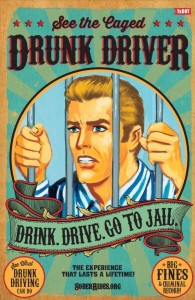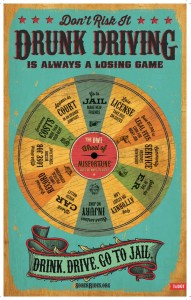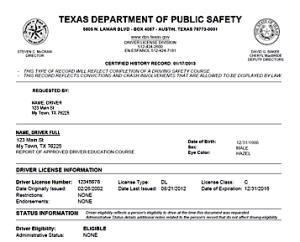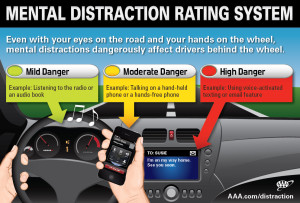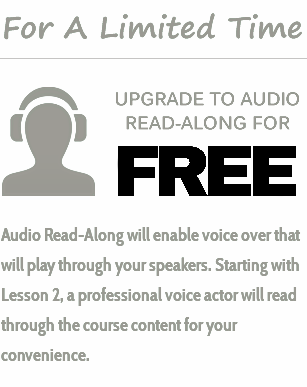The development team at iDefensiveDriving.com wanted to take a brief moment to remind you how important you are, and that many loved ones are counting on you to be there everyday. So please take a moment to watch this inspiring video and remember to never “Drink & Drive”. We want to wish you a very Merry Christmas and look forward to seeing you driving “safely” in Texas.
Archives
As we approach the holiday season, iDefensiveDriving.com would like to take a moment to remind you of these simple, yet important tips, to keep you safe and secure while driving on Texas roadways.
• Always ensure that your vehicle is properly maintained. If your vehicle maintenance is not up to date, have your vehicle and tires inspected before you start your trip.
• Go online and map your route in advance. Be prepared for busy roadways during the holiday season. If possible, consider leaving earlier, or later to avoid heavy traffic.
• Keep all valuables, gifts, and packages in the trunk or covered storage areas of your vehicle, to avoid the temptation for a vehicle break-in.
• If you’re traveling with children, remind them not to talk to strangers. Go with them on bathroom breaks, and give them radios or cellphones in case you accidentally get separated.
• Have roadside assistance contact information on hand in case an accident, flat tire, or mechanical failure occurs while traveling.
• Never drink and drive. If you happen to enjoy an alcoholic beverage at a holiday party, wait until you are completely sober, or call a taxi, or other designated driver to take you to your chosen destination.
The staff at iDefensiveDriving.com would like to wish you a happy and blessed holiday season, and we look forward to seeing you driving “safely” in Texas.
Although a balanced diet and exercise are two major factors in maintaining a healthy weight and lifestyle, sleep deprivation and stress can greatly impact our immune system, energy levels, focus and concentration, and the ability to fight that dreaded BELLY FAT.
Here are two qualified recommendations to help keep your waistline trim and your overall health in check.
GET MORE SLEEP
If you’re among the 30% of Americans who sleep less than 6 hours a night, there’s one simple way to whittle your waistline… catch more Zzzz’s.
A 7-year study of 70,000 men and women found that those who slept 5 hours or less a night were 30% more likely to be 30 pounds or more overweight and suffer more overall stress. The National Institutes of Health (NH) suggests that adults should sleep 7-8 hours a night for optimal health.
LOWER YOUR STRESS LEVELS
I think we can all agree that “muffin tops” (the fat hanging over the waist of a too tight pair of pants) and “pot-bellies” aren’t attractive. Still, when it comes to excess belly fat, the situation is much more serious than how we look. Excess belly fat has been linked to diabetes, cardiovascular disease, and cancer.
When you have stress, your body releases certain “fight-or-flight” hormones that are produced in the adrenal glands: cortisol, norepinephrine and epinephrine. When you first get stressed, these hormones kick into gear.
Norepinephrine tells your body to stop producing insulin so that you can have plenty of fast acting blood glucose ready. Epinephrine will relax the muscles in your stomach and intestines and decrease blood flow to these organs. Once the stressor has passed, cortisol tells the body to stop producing these hormones and to go back to digesting regularly. It’s normal for your cortisol levels to go up and down throughout the day, but when you are chronically stressed, your cortisol levels go up, and stay there.
When your stress and cortisol levels are high, the body actually resists weight loss. Your body thinks times are hard and you might starve, so it hoards the fat you eat. Cortisol will also take fat from healthier areas, like your butt and hips, and move it to your abdomen (thus creating the Big-Gut / No-Butt syndrome). In the process, it turns once healthy peripheral fat into unhealthy visceral fat (the fat in your abdomen that surrounds your organs). This belly fat then leads to more cortisol production. The more belly fat you have, the more cortisol you will have, and the cycle goes on and on.
So in addition to getting more sleep, find effective ways to reduce your stress, such as listening to relaxing music, taking an evening stroll, hitting the gym for an intense workout, watching a funny movie (it is often said that laughter is the best medicine), and spending time with a loved one… Researchers at the University of North Carolina at Chapel Hill recently found that (the cuddle cure) holding hands and hugging can measurably reduce stress.
This has been another “Helpful Tips & Tools” post from iDefensiveDriving.com. We hope to see you well rested and healthy, and driving “safely” in Texas.
An old and dear friend of mine always says, “If you want to improve your Altitude, you’ve got to improve your Attitude“… meaning if you want to move up in life, you’ve got to have the right focus, ethics and demeanor. However this morning, as I was getting ready for work, my beautiful wife and the President of iDefensiveDriving.com said, “If you want to improve your Attitude (referring to my health, happiness and longevity), you’ve got to improve your Altitude… stand up straight, pull your shoulders back, and recapture your vigor and youthful appearance.
I thought about that for a few moments, as I stood glancing in the bathroom mirror, realizing that I was standing a little slumped over these days. I had been letting long work hours take their toll, and missing out on the benefits of physical activity, proper nutrition and a restful nights sleep. Therefore, I decided it was time to make a change!
Although I do not purport to be a fitness or health expert, I have gained enough experience over the years to know that I need to start with the end in mind, establish a plan that allows for both short and long term successes, and the opportunity to fail-forward (turn my mistakes into stepping stones).
So I decided to start with improving my posture, by improving my core. Practicing good posture is a very important way to maintain a healthy mind and body. When you practice correct posture, your body is in alignment with itself. This can alleviate common problems such as back or neck pain, headaches, and fatigue. In fact, many qualified studies show that being in good general health and standing (or sitting) tall will also improve your self confidence and overall success. Here are a few tips from my posture improvement plan.
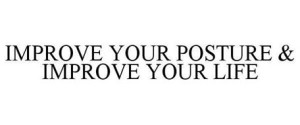 Sit up straight! How often did your parents tell you that? For many people, this suggestion got filed right next to “eat your peas”. Mom was right though, at least about your posture. Today, especially when so many of us sit at a desk all day, it’s important to follow these basic guidelines both for your posture and for your health.
Sit up straight! How often did your parents tell you that? For many people, this suggestion got filed right next to “eat your peas”. Mom was right though, at least about your posture. Today, especially when so many of us sit at a desk all day, it’s important to follow these basic guidelines both for your posture and for your health.
At Your Desk
- If you work long hours at a desk and have the option, use a chair that’s ergonomically designed for proper support. If this is not an option, try using a small pillow for lumbar support.
- Align your back with the back of the office chair. This will help you avoid slouching or leaning forward.
- As with standing posture, keep your shoulders straight and squared, your head upright, and your neck, back, and heels aligned.
- Keep both feet firmly on the ground.
- Adjust your chair and your position so that your arms are flexed, not straight out. Aim for roughly a 75 to 90 degree angle at the elbows. If they are too straight, you’re too far back, and if they are more than 90 degrees, you’re either sitting too close, or you are slouching.
In Your Car
Start with good sitting posture. Not only is good posture while driving, recommended for good posture’s sake, it’s also important for more practical safety concerns. Your car’s seating and protective systems were designed for people sitting properly in the seat, and will improve your safety in the event of a collision.
- Keep your back against the seat and head rest.
- Adjust your seat to maintain a proper distance from the pedals and steering wheel. If you’re leaning forward, pointing your toes, or reaching for the wheel, you’re too far away. If you are bunched up with your knees touching the dash, or chin on top of the steering wheel, you’re too close.
Adjust the head rest. The head rest should be adjusted so that the middle of your head rests against it. Tilt the head rest as needed, to maintain a distance of no more than four inches (10cm) between the back of your head and the head rest.
So keep your head up, your shoulders back, and sit and stand tall for improved health and well being.
– RJB
These days, it seems like everyone is working more hours and using the old “no-time-to-exercise” excuse, more and more. But what if you could actually work out at your desk, or even while taking a driver’s safety class from iDefensiveDriving.com?
While you won’t get into the Olympics this way, you can do stretching, muscle-strengthening, and even short stints of aerobic exercises right at your desk and around your office. After all, doctors say that any amount of exercise helps… and the benefits are cumulative!
Here are a few suggestions for working out at your desk, and around your office from iDefensiveDriving.com:
Use an exercise or balance ball as your desk chair
- Sit up straight on the ball with your legs out in front of you, and your feet firmly on the floor. At first, you can place your calves so that they are touching the ball. This will give you added stability, while learning to use the ball. Later, you will want to move your calves, so they are not touching the ball, which will provide more benefits for your core.
- Bend your elbows and place your forearms at a 90 degree angle. While reaching forward slightly, you should be able to rest your forearms on the top of the desk or table. If you are using a computer, make sure it is at a 90 degree angle. If it is not, your neck will be out of alignment with the rest of your spine, and the ball will be less useful in helping to improve your posture.
- Practice active sitting. This is the state when your body reacts to the prospect of falling off the ball by tightening your core muscles in your stomach and back. Flex the muscles in your abdomen to add an extra element of exercise. Hold the flex for 30 seconds and release. As you become more adept, practice slowly rocking your hips and abdomen backward and forward, side to side, and in small circular motions.
- Use the ball in 10-20 minute intervals. Do not get rid of your office chair. Just like exercise, it is important to give your muscles rest to prevent muscle fatigue, and to receive the maximum benefit.
- Work up to 30 minute intervals as you get used to the chair. Doctors do not recommend that you sit for longer than 30 minutes at a time.
Walk it out
- Whenever you get up to change chairs, take a brief walk around the office to stretch your legs, abdomen, and lower back. Loosen up your neck, arms and shoulders by doing arm and neck rotations.
- If available, walk an occasional flight or two of stairs. Walking stairs provides an efficient low-impact cardiovascular workout that also builds strength in your lower body. The vertical nature of stairs presents a unique challenge for the quadriceps, hamstrings and glutes. Most exercise and athletic activity consists of moving forward or laterally, such as jogging, walking and cycling. Whereas the upward motion used to climb stairs requires your body to move in an alternative direction. Working your muscles from different angles can help you to maximize muscle growth, burn more calories and improve your overall health.
This has been another weekly update from iDefensiveDriving.com. We look forward to seeing you driving “safely” in Texas.
It’s a cool and rainy morning here at the iDefensiveDriving.com headquarters in Southeast Texas, and what a treat I had, when I pulled into our local McDonald’s to get a cup of coffee. As I pulled up to the window to pay, using a fair amount of defensive driving skills, (apparently Southeast Texans love their McDonald’s), I met a joyful cashier who started our conversation with… “Good Morning, on this beautiful rainy day!”. After a short exchange of pleasantries, I inquired as to how much I owed for the coffee, and with a big smile, the cashier stated, “No Charge, we are offering FREE cups of coffee every morning for the next two weeks”.
Here is a link to the McDonald’s promotion
So whether you are driving in the rain or shine, be sure to utilize your “safe and defensive” driving skills, and if you have the occassion, pull into your local McDonalds for that FREE cup of coffee. Be sure to tell your smiling cashier that you were referred by the good ‘ole boys and girls down at iDefensiveDriving.com
– RJB
Hopefully you don’t need any reason not to drink and drive, but if you do, here are three compelling reasons from iDefensiveDriving.com:
Reason #1 – Life & Death
Under the influence of alcohol is the number one cause of motor vehicle related deaths in the United States. It is a proven fact, that a driver under the influence of even one drink will have a slower reaction time, and decreased judgment when driving.
If you are convicted of drinking and driving it will likely cost you thousands of dollars. The court costs and related fines for a first time DUI/DWI offender, will range anywhere from $500 to $5000. The severity of the offense, and if an accident or accident related injury or death was involved, could increase those costs and fines substantially. Your auto insurance will increase due to the DUI/DWI and you will need to file an SR-22 insurance form. An SR-22 will affect your premiums for up to five years, and you can expect your auto insurance premium to increase by 100% if you are convicted of a DUI/DWI.
Reason #3 – Poor Future Outlook
In addition to the financial burden of fines and court costs, your future is not going to be as bright. Many employers do not hire individuals with DUI/DWI convictions, and if your current job involves driving you may lose your job. This can have a dramatic effect on your financial future, and can be hard to overcome.
So stay sober when driving, and if you drink, make sure to call a cab or have a designated driver.
We look forward to seeing you driving “safely” in Texas.
Here at the iDefensiveDriving.com headquarters, we often get a lot of questions about traveling with a firearm. Whether you are traveling by plane, train or automobile, you should remain informed and updated on current state and US laws, pertaining to and regulating the possession of a firearm while traveling. It is often said that misinformation or a lack of information is not a defense to prosecution, and in the case of traveling with a firearm, you should always err on the side of caution.
Here is a great link to help you stay current on the rules and regulations pertaining to traveling with a firearm:
Guide to the Interstate Transportation of Firearms
… And even though this is a recommend link, always do your own “due diligence” before traveling with a firearm.
Here are a few tips from iDefenisveDriving.com on the best times to buy a new car…
- Early in the week: Most people shop on weekends when dealerships are full, buyers are abundant, and sales teams can get a higher premium on each vehicle sold. By shopping early in the week and avoiding the crowd, you will have a better chance of finding a salesperson who is motivated to make a sale, and willing to negotiate a better deal.
- Late in the day: Like most working folks, sales teams are anxious to get home and spend time with their families. They will not want to spend additional time, after hours, negotiating a deal. So, if you’ve done your homework, and already know exactly what vehicle you are looking for, this would be a great time to pay the dealership a visit.
- End of month/quarter: Car dealers and sales teams must meet monthly/quarterly goals, to earn their bonuses and incentives; therefore, this would be a good time to find a salesperson who has yet to meet their monthly/quarterly goal, and is willing to do whatever it takes to close the deal.
- When new models come out: New model vehicles usually come out at the end of summer. During this time, dealerships will want to make room for their new inventory, and are more willing and motivated to sell their current inventory at the price you want. So do your research, find out when the new model of the car you want is coming out, and go pay the dealership a visit just before this time.
- End of year: At the end of the year, dealerships are trying to meet year-end quotas, and reduce the fees and taxes they pay on year-end inventory. Sales teams are trying to meet year-end quotas that may award them bigger holiday bonuses. This is the perfect combination for new-car shoppers looking to find a great deal.
Stay tuned for more weekly updates from iDefensiveDriving.com
Don’t follow too closely behind the car in front of you. Always leave at least 2-4 seconds of travel time between your car, and the car you are following.
Some experts will tell you to leave a minimum of 4 seconds; although other experts believe that the 4-second rule may invite other drivers to cut to closely into the lane in front of you, which can cause other serious traffic hazards.
While this may sound like a tip that applies to simply being a better driver, this tip also promotes defensive driving principles for emergency situations.
In the event of an urgent or abrupt stop ahead of you, your car will have more time and space to avoid a rear-end collision. This helps the driver behind you as well, because it improves their reaction time and stopping distance – which will be a big plus if they haven’t been paying attention, are slow to react, or drive a vehicle with a longer braking distance (such as an SUV).
So keep your distance and improve your driving outcomes.
This has been another “safe and defensive” driving update from iDefensiveDriving.com
Intersections are inherently dangerous places, and the scene of many serious accidents. Most drivers, upon seeing a red light turn to green, proceed straight through the intersection without having a second thought. This can be an extremely dangerous habit, and one that will be hard to recover from, if a driver on the intersecting roadway isn’t paying attention, or decides to run their red light and crashes into your vehicle… usually at a high rate of speed.
The United States Department of Transportation, reports that intersection-related crashes, result in more than 7000 fatalities and over 100,000 injuries in the United States each year.
When you are the first car at an intersection, when the traffic light is turning green, you should pay close attention to the oncoming traffic on your left, and then on your right, before proceeding through the intersection. This two to three second delay, could very well prevent a serious accident, and ultimately save your life.
This has been another weekly “safe and defensive driving” tip from iDefensiveDriving.com
We look forward to seeing you driving “safely” in Texas!
Rather than keeping your eyes fixed on the car right in front of you, keep your eyes focused on the horizon (a technique that race car and other professional drivers call “high-eyes”).
Many urban drivers become fixated on the car right in front of them, and become lulled into an autopilot mode; braking when the car in front of them brakes, and accelerating when the car in front of them accelerates. This can be a very BIG problem if the driver in front of you is not paying attention, and doesn’t brake in time to avoid hitting the car that came to an abrupt stop in front of them… if your eyes were fixed on the back of their car, you will most likely be a party to the accident.
If you keep your eyes focued on the horizon, you will be better equipped to see any activity that may cause an accident well before it happens, and you will have plenty of time to adjust accordingly.
This has been another weekly “safe driving” tip from iDefensiveDriving.com
While other defensive driving courses charge an extra $20 or more to “expedite” the processing of your Driver Record. Texas drivers can order their Driver Record online, directly from DPS, and print it out immediately for only $10.00.
Simply follow the steps below:
- Go to https://txapps.texas.gov/tolapp/txldrcdr/TXDPSLicenseeManager
- Follow the printing requirement checklist
- Install Adobe Reader if necessary
- Perform Print Test
- Check Adobe acknowledgement and Continue
- Create Login
- Request a Type 3A Certified Driver Record (The cost is $10.00)
- Review order and make payment
- Print Driver Record
That’s it…you’re done! You now have a certified copy of your Driver Record, accepted by Texas courts for Defensive Driving Courses (DDC).
Just some friendly advice from iDefensiveDriving.com.

Today, the Web is accessible from almost everywhere. Our desktops, laptops, tablets, and smartphones, allow us to access content anywhere, anytime we have an internet connection. This also means that there is a need to show content in many ways, optimized to different environments.
A recent Google Survey found that we frequently move between our devices to meet our primary needs.
At iDefensiveDriving.com, your convenience is a priority to us, so we want you to have access to your course from all of your internet ready devices. You don’t have to be stuck in your office or home in front of a desktop computer. You can complete the iDefensiveDriving.com, Driver Safety Course from anywhere, anytime!
Human beings are prone to operating on “autopilot”, especially on familiar roads. Our minds wander from operating our vehicle to other things, such as work related issues, our children’s after school activities, what to cook for dinner, etc… It is virtually impossible to keep this from occurring, but it is vitally important to recognize it when it is happening, and bring our attention back to the task of driving as quickly as possible. Another way drivers become distracted is by modern technology. From our cellphones, to our tablets, to extravagant in dash navigation and entertainment systems… there are so many new distractions in our vehicles, it’s a wonder we are capable of driving at all.
One of the most important aspects of defensive driving is recognizing impending hazards BEFORE they become a problem. Early recognition allows the time you need to avoid trouble. Therefore, keeping your eyes on the road, and your attention focused on the task of driving, will dramatically improve your safety, and the safety of those around you.
Stay “Alert” my friend… We look forward to seeing you driving “Safely” in Texas.
This has been another weekly “Driver’s Safety” update from iDefensiveDriving.com







